Poor Man's Silver
by
Bob Brooke
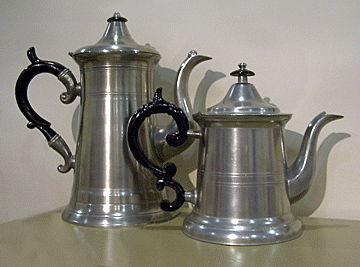 Colonial
housewives cherished their pewter. To fool their guests into thinking
they were wealthier than they were, they proudly displayed their pieces
on shelves since, when highly polished, it resembled silver. Colonial
housewives cherished their pewter. To fool their guests into thinking
they were wealthier than they were, they proudly displayed their pieces
on shelves since, when highly polished, it resembled silver.
Pewter vessels have been around since ancient times. The Romans made and
used them daily. Churches used pewter candlesticks, chalices, and alms
dishes until 1175 when silver and gold came into favor. But when they
contributed their silver and gold pieces to ransom Richard the
Lion-Hearted during the Crusades, they turned back to pewter. This
encouraged the daily use of pewter in Europe. Craftsmen’s guilds, such
as the Worshipful Company of Pewterers in England, supervised its
quality and production.
Early Pewter
It was only natural that pewter became widely used in early America. Not
only did immigrants bring vessels with them, but also pewterers,
themselves, immigrated to the New World. As early as 1610, pewter
appeared in Jamestown, Virginia, and by the 1630s in New England. By
1640, the Massachusetts Bay Colony boasted five active pewterers.
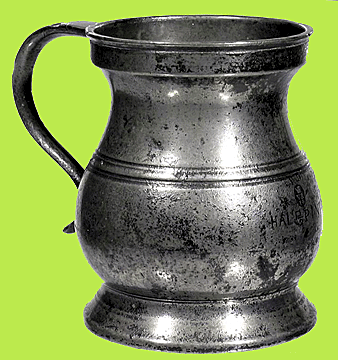 The early colonists considered pewter a valued possession, and often
engraved it with their initials. Originally, most of their pewter ware
came from London. Because the English Board of Trade protected English
pewterers by prohibiting the export of pure tin to the Colonies and
laying a heavy excise tax on unworked pewter but not on finished vessels
made for export, American merchants could import pewter vessels almost
as cheaply as local pewterers could import new ingredients. This forced
colonial pewterers to do repairs or to buy worn pewter vessels at 50-70
percent of their original cost to melt down and cast as new items. The early colonists considered pewter a valued possession, and often
engraved it with their initials. Originally, most of their pewter ware
came from London. Because the English Board of Trade protected English
pewterers by prohibiting the export of pure tin to the Colonies and
laying a heavy excise tax on unworked pewter but not on finished vessels
made for export, American merchants could import pewter vessels almost
as cheaply as local pewterers could import new ingredients. This forced
colonial pewterers to do repairs or to buy worn pewter vessels at 50-70
percent of their original cost to melt down and cast as new items.
After the mid-1760s, imported salt-glazed English pottery challenged
pewter as the tableware of choice. The market for pewter further
declined after the introduction of Josiah Wedgwood's improved creamware,
with its low cost, durability, and light and handsome appearance that
mistresses of the house found appealing. By 1774, people used pewter
mainly in their kitchens while china appeared in their dining rooms.
Those living on the frontier prized their pieces long after they had
gone out of style along the East Coast.
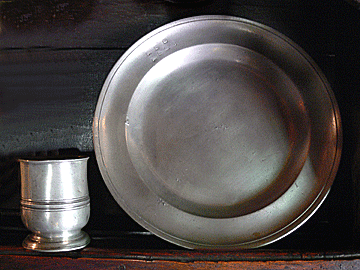 By 1825, pewters abandoned making pewter plates, and by 1850, people
stopped using pewter. However, the Centennial Exposition in Philadelphia
once again brought attention to it, and manufacturers began producing
pewter objects to meet the demand for Colonial Revival accessories. The
restoration of Colonial Williamsburg in 1925 again created an interest
in pewter through its fine reproductions. By 1825, pewters abandoned making pewter plates, and by 1850, people
stopped using pewter. However, the Centennial Exposition in Philadelphia
once again brought attention to it, and manufacturers began producing
pewter objects to meet the demand for Colonial Revival accessories. The
restoration of Colonial Williamsburg in 1925 again created an interest
in pewter through its fine reproductions.
Making Pewter
Pewter is duller, darker, and softer than silver. Unlike silver, a
precious metal, pewter is an alloy. Its main ingredient was tin and
since there were no tin mines in America, pewterers had to import it
from England by paying a heavy tax.
To help harden the tin, pewterers added copper, antimony, and bismuth in
varying amounts, depending on their desired result. Fine pewter
contained 90 percent tin and 5 percent lead to make it easier to work.
The more lead it contained, the softer it was and the poorer its
quality. Makers added a small amount of bismuth to ensure sharp, neat
castings. By adding copper to the mixture–up to 20 percent for the
finest pewter–they could give it a clear ring and smoother surface.
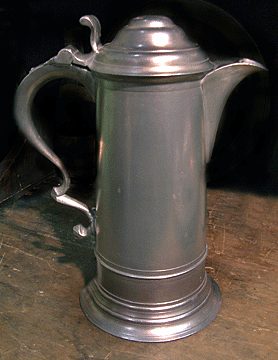 Pewterers used the tin-copper alloy to make trenchers, chargers, and
other flat-ware and a tin-antimony combination to make spoons, salts,
and other small articles. The latter became known as trifle while pewter
with a heavy lead content became known as ley metal. Pewterers used this
to produce drinking vessels and an even heavier mixture with 40 percent
lead for candle molds and organ pipes. And because no such organization
as the Pewterers' Society existed in the Colonies, American pewter
varied in quality more than its English counterpart. Pewterers used the tin-copper alloy to make trenchers, chargers, and
other flat-ware and a tin-antimony combination to make spoons, salts,
and other small articles. The latter became known as trifle while pewter
with a heavy lead content became known as ley metal. Pewterers used this
to produce drinking vessels and an even heavier mixture with 40 percent
lead for candle molds and organ pipes. And because no such organization
as the Pewterers' Society existed in the Colonies, American pewter
varied in quality more than its English counterpart.
To create his pieces, a pewterer had to use molds made of brass or
bronze. Unlike in England where braziers made the molds and sold them to
pewterers, colonial pewterers made their own, enabling them to also
control the designs of their pieces. And though pewter designs changed
over time, the considerable effort and cost of materials that went into
each new set of molds restricted pewterers from being slaves to fashion,
thus older forms continued in use long after new ones appeared.
To create a new mold, a pewterer first made a model of the piece in wood
or lead. He then prepared a sand mold by impressing the wooden pattern
into the sand, after which he poured in molten brass. This produced a
brass facsimile of the wooden pattern.
Before using his new mold, a pewterer coated it with a light layer of
calcinated pumice stone or soot. He’d then heat the mold, and as soon as
it was slightly warm, he spread nitric acid over it with a feather, and
after it effervesed, he’d dust on a coating of powder. He then poured in
the molten pewter alloy.
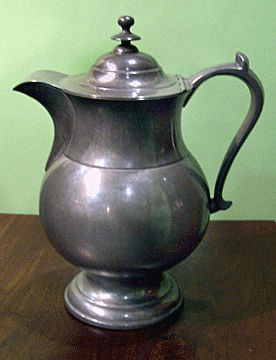 A pewterer with good molds could make many castings in an hour. He threw
poor castings back into the melting pot, and filled joints and small
holes in good pieces with a soldering iron, using scraps of pewter as
solder, which caused the joints to disappear after polishing. He scraped
and burnished spoons and the handles of porringers and mugs by hand and
finished round forms on a lathe. After mounting plates, basins, dishes,
mugs, and tankards–known as hollowwares–on his lathe, he’d skim them
with a "hook"or other cutting or scraping tool to smooth the inner
surfaces of the molded parts so they would fit tightly together to
prevent leakage. These skimming marks appear as shallow, concentric
ridges and grooves on the bottoms of round objects. Also visible are
"chatter" marks, coarse radial lines extending from the center toward
the circumference, caused by the vibration of the skimming tool.
Skimming marks on early pewter are coarser than the chatter marks. A pewterer with good molds could make many castings in an hour. He threw
poor castings back into the melting pot, and filled joints and small
holes in good pieces with a soldering iron, using scraps of pewter as
solder, which caused the joints to disappear after polishing. He scraped
and burnished spoons and the handles of porringers and mugs by hand and
finished round forms on a lathe. After mounting plates, basins, dishes,
mugs, and tankards–known as hollowwares–on his lathe, he’d skim them
with a "hook"or other cutting or scraping tool to smooth the inner
surfaces of the molded parts so they would fit tightly together to
prevent leakage. These skimming marks appear as shallow, concentric
ridges and grooves on the bottoms of round objects. Also visible are
"chatter" marks, coarse radial lines extending from the center toward
the circumference, caused by the vibration of the skimming tool.
Skimming marks on early pewter are coarser than the chatter marks.
Although American pewterers cast most handles separately and soldered
them in place after the drums of mugs and tankards had been skimmed and
polished, they cast others, like those on porringers, in place because
this practice ensured a stronger bond between the handle and the bowl
than they could achieve by soldering. The only exception were the
handles on Pennsylvania tab-handle porringers, which have their bowls
and handles cast as one piece.
To produce a good bond, a pewterer shaped the base of the handle mold to
exactly fit the porringer bowl. He held the bowl with metal tongs with
curved ends, which he wrapped in cloth, that perfectly conformed to the
inner contours of the bowl. In a process called fusing, the cloth served
as a tinker's dam preventing the hot metal poured into the handle mold
from melting a hole in the bowl and impressed its pattern on the
softened metal of the bowl's inner surface. Early pewter porringers thus
have what’s called a “linen” mark, made by the impression of the cloth.
Reproduction porringers, with soldered on handles, don’t have linen
marks.
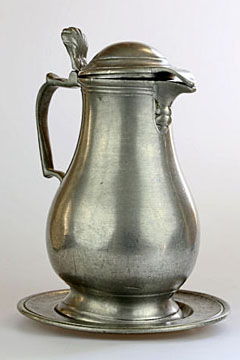 American pewterers didn’t begin to make hollow mug and tankard handles
until the beginning of the 18th century. Since molten pewter congeals
first where it’s in contact with the mold, pewterers would up-end a mold
and pour out the remaining molten metal, leaving the casting hollow. American pewterers didn’t begin to make hollow mug and tankard handles
until the beginning of the 18th century. Since molten pewter congeals
first where it’s in contact with the mold, pewterers would up-end a mold
and pour out the remaining molten metal, leaving the casting hollow.
Pewterers cast plates in a two-part hinged mold. They didn’t begin to
hammer them until the late 18th century, and then only on the curved
portion known as the booge. In old pewter, these barely visible hammer
marks resulted from the production process and weren’t meant for
decoration as in early 20th century pieces.
Since casting molds were expensive, pewterers tried to use each one for
as many different pieces as possible. They might use the same body mold
for a teapot, sugar bowl, and pitcher, with the appropriate spout, lid,
or handle being added later. In this way, a pewterer could offer a full
range of objects to customers without buying a large number of molds.
When a pewterer died or went out of business, he passed his molds on to
other family members or sold them to other pewterers.
Finishing was what gave pewter its unique luster. Pewterers burnished or
buffed pieces while the piece was still in the lathe by holding a
burnishing tool against the object as it rapidly turned. The tool had a
polished stone or steel face that pushed and flattened small rough areas
still left on the surface. This process didn’t remove metal. After 1825,
they buffed their pieces using a rapidly rotating buff, made of pieces
of hide or cloth used with a finely ground abrasive polishing powder. As
a final step, American pewterers often cut decorative lines into the rim
and well of their plates and on the outside of their holloware.
American pewterers began using a process called spinning to shape their
pieces around 1825. They’d shape a thin, flat sheet of metal by pressing
it on a lathe, against a wooden form called a chuck. Spinning eliminated
the casting and hammering processes and made it possible for pewterers
to create lighter vessels in a wide variety of shapes. Spun pieces show
no hammer marks.
I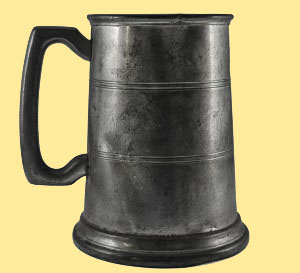 n 1827, American pewterers started using stamping. With this, they
shaped a flat sheet of metal between a male and a female die in a screw
press, to form various parts for their wares. Often, they had to use a
successive series of ever deeper dies for deep objects in order to keep
the metal from wrinkling or breaking. n 1827, American pewterers started using stamping. With this, they
shaped a flat sheet of metal between a male and a female die in a screw
press, to form various parts for their wares. Often, they had to use a
successive series of ever deeper dies for deep objects in order to keep
the metal from wrinkling or breaking.
Eventually, five main American pewter-making centers developed—Boston,
Rhode Island, the Connecticut Valley, New York, and Pennsylvania. Each
had its own variations in style and design and featured a different type
of ware. For instance, Boston pewterers made only plates and basins.
Many American pewterers identified their works by stamping their pewter
with a mark called a touchmark. While they used English touch designs,
such as the rampant lion and rose and crown, before the Revolutionary
War, afterwards they used the patriotic American eagle, which they
copied from coins issued by the new republic in 1792.
Pewter Marks
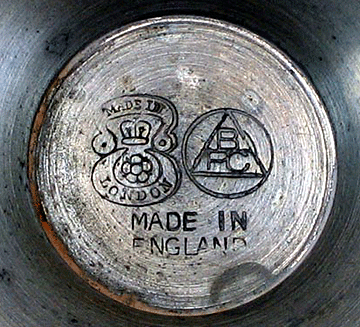 After 1825, many used only their name in a rectangular frame. Sometimes
a pewterer used only his initials or a symbol which he adopted as his
own. At first, they punched their names with a die which punched in the
metal around the letters, leaving them in relief. After 1830, they
incised their names into the metal. Early New York and Pennsylvania
pewterers often placed a crowned X above or below their name to show
they had used the finest pewter alloy. Others employed a series of four
smaller marks, struck in a row and commonly called "hall marks." While
these indicate particular information on silver, they have no meaning on
pewter. After 1825, many used only their name in a rectangular frame. Sometimes
a pewterer used only his initials or a symbol which he adopted as his
own. At first, they punched their names with a die which punched in the
metal around the letters, leaving them in relief. After 1830, they
incised their names into the metal. Early New York and Pennsylvania
pewterers often placed a crowned X above or below their name to show
they had used the finest pewter alloy. Others employed a series of four
smaller marks, struck in a row and commonly called "hall marks." While
these indicate particular information on silver, they have no meaning on
pewter.
Many collectors believe all unmarked pewter is American pewter. While
much of it had no mark, many pieces, such as whale-oil lamps of the
1830s-1850s, were never made or used elsewhere. Also, it was common
practice to mark only one piece of a matched set.
Uses for Pewter
Colonials used all sorts of pewter vessels. They ate porridge, mush, and
stew daily with pewter spoons and drank beer from pewter pint-sized mugs
called "cue-cups." Babies often took first took their milk from a pewter
"sucking bottle." As children, they drank milk and later as adults, they
drank cider, beer, and ale in pewter mugs. Merchants imported small
items such as snuffboxes and buckles. But the most common item was the
plate.
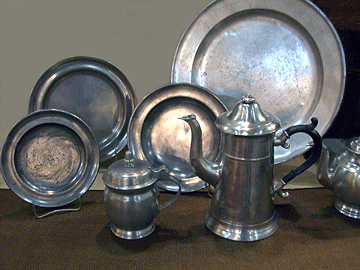 In the 18th century, people called plates, basins, and dishes "sadware,”
not because they looked bad, but because they were heavy. American
pewter tablewares before 1725 consisted of plates eight or nine inches
in diameter, flat or deep dishes more than ten inches in diameter, open
salts, porringers, mugs, tankards, and basins. Some pewterers made large
chargers up to 13 inches in diameter. In the 18th century, people called plates, basins, and dishes "sadware,”
not because they looked bad, but because they were heavy. American
pewter tablewares before 1725 consisted of plates eight or nine inches
in diameter, flat or deep dishes more than ten inches in diameter, open
salts, porringers, mugs, tankards, and basins. Some pewterers made large
chargers up to 13 inches in diameter.
A dinner set of pewter comprised three dozen dishes and plates, one
dozen saucers, a tankard or flagon, salts, mustard pot, pepper box, half
a dozen mugs, and one or two dozen spoons. Mistresses of the house
arranged their sets on a sideboard or dresser with shelves called a
pewter rack. Pewterers dubbed a complete set of a dozen platters, a
dozen flat bowls, and a dozen small flat plates a garnish.
One of the most unique items was a double-bottomed dish with a small
hinged lid leading to the enclosed space in between, into which people
could pour hot water, enabling colonial housewives to both serve and
keep food warm while eating.
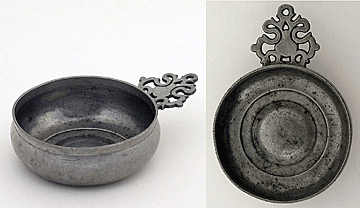 The porringer was a multipurpose bowl with a slightly domed bottom,
ranging from five and a quarter inches—the most common diameter—to two
and a quarter inches, called a wine-taster, which held exactly the same
amount of fluid as a modern one-ounce whisky glass. They could be used
to serve either solid foods or liquids. Colonial physicians also used
these small porringers when bleeding their patients. In addition, there
were beer and wine pint porringers, enabling tavern owners to use them
as measuring devices for alcoholic beverages. The porringer was a multipurpose bowl with a slightly domed bottom,
ranging from five and a quarter inches—the most common diameter—to two
and a quarter inches, called a wine-taster, which held exactly the same
amount of fluid as a modern one-ounce whisky glass. They could be used
to serve either solid foods or liquids. Colonial physicians also used
these small porringers when bleeding their patients. In addition, there
were beer and wine pint porringers, enabling tavern owners to use them
as measuring devices for alcoholic beverages.
The handles of porringers offer a clue to their origin. Those with
pierced or openwork handles were popular in New England, especially
Connecticut. Craftsmen in Newport, Rhode Island turned out porringers
with solid pear-shaped handles. New York pewterers turned out the more
handsome scrolled, flowered handle while the Pennsylvania Germans
favored a solid handle formed like a tab.
Pewterers produced spoons in all sizes and for all purposes. There were
cooking spoons and ladles, teaspoons, and small salt spoons, as well as
sugar scoops. But spoons, like porringers, didn’t last long under daily
use since their design didn’t allow for the added stress. Also,
Colonials had them melted down whenever they got too worn or broken.
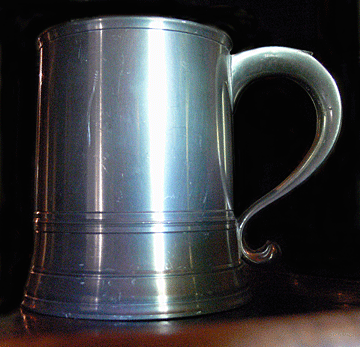 After porringers, tankards were the most common type of American pewter
holloware. Like their silver cousins, pewter tankards date from the 18th
century. Later ones often have a double dome, occasionally with a
finial. Some were pear- or tulip-shaped. After 1790, people began using
mugs for drinking and measuring. After porringers, tankards were the most common type of American pewter
holloware. Like their silver cousins, pewter tankards date from the 18th
century. Later ones often have a double dome, occasionally with a
finial. Some were pear- or tulip-shaped. After 1790, people began using
mugs for drinking and measuring.
Basins, used to serve stews and vegetables, came in a variety of sizes
from less than three inches in diameter to over ten and in two basic
shapes–the standard bowl and the basin. The standard shape has bulging
sides, a bottom with a domed center surrounded by a flat ring-shaped
gutter, and a narrow collar around the top. The basin bowl, which came
in small and large sizes, is a basin with a handle attached. American
pewterers didn’t hammer them.
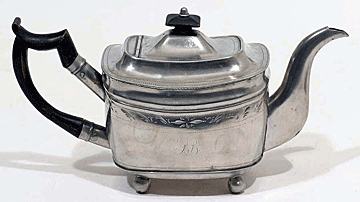 When the luxury of tea and coffee drinking began to spread, some
pewterers turned to making pewter teapots and coffeepots. After the
Civil War, teapots and coffeepots began to be made in highly decorated
sets—with matching sugar bowls, cream pots, slop bowls, and a three-foot
tray. Expensive sets included a kettle-on-stand with a burner, which
supplied extra hot water as needed. Many of the teapots were of one- or
two-quart size. Because tea was more available than it had been a
century before, people didn’t have to brew it in small pots. And
although coffee-pots became more numerous, they were still less common
than teapots. When the luxury of tea and coffee drinking began to spread, some
pewterers turned to making pewter teapots and coffeepots. After the
Civil War, teapots and coffeepots began to be made in highly decorated
sets—with matching sugar bowls, cream pots, slop bowls, and a three-foot
tray. Expensive sets included a kettle-on-stand with a burner, which
supplied extra hot water as needed. Many of the teapots were of one- or
two-quart size. Because tea was more available than it had been a
century before, people didn’t have to brew it in small pots. And
although coffee-pots became more numerous, they were still less common
than teapots.
Pewterers made candlesticks in pairs from 6 to 12 inches tall. Chamber
sticks, made with a saucer-like base to catch dripping wax and a finger
loop, were under five inches tall.
<
Back to Antiques Articles
Next Article >
|
